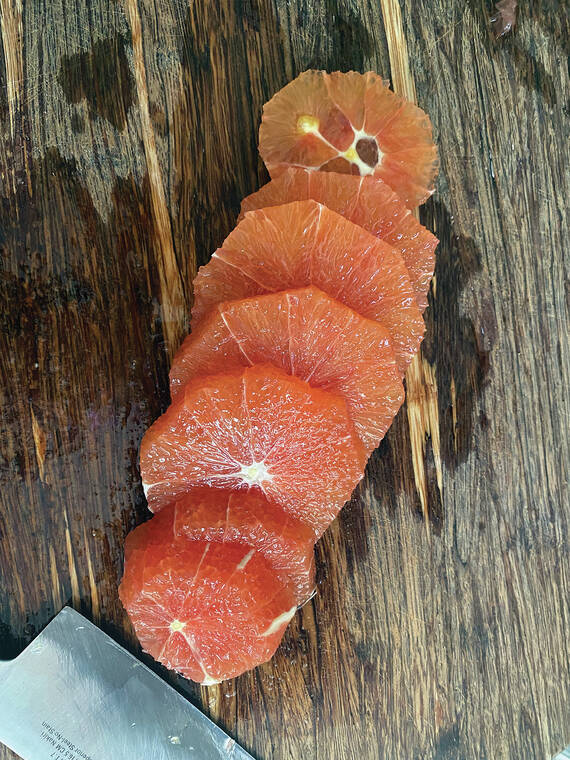You might have seen Cara Cara navel oranges at the market and wondered about them.
They are actually a natural mutation of a Washington Navel orange, discovered in Venezuela in the last 20th century.
They are named after the family estate where they were initially discovered in Venezuela.
Hacienda Cara Cara was located in the municipality of San Diego. Hacienda Cara Cara was purchased by Don Miguel Gimenez Fumero in 1936 to raise cattle for milk production. There were, at that time, some unfavorable policies that hurt the milk industry so the family sold their cattle and planted orange trees instead.
In 1950, a branch of a Washington California Navel started to produce fruits with red interiors and a red-brown bark on the property.
This natural mutation posed a mystery to the family so they sent budwood to Florida in 1988. Evaluated and tested for several years and trees were planted in California, Texas and even in Spain.
Cara Cara oranges have been called by other names such as Pink Navel, Red Navel, Red Orange, Red-Flesh Navel, and Naranjas Cara Cara.
Cara Cara oranges are a great source of vitamin C, A, potassium, calcium, manganese, phosphorus, zinc, copper, and iron. In fact, it contains twenty percent more vitamin C and thirty percent more vitamin A than in other navel oranges.
The red flesh is created by the presence of carotenoid lycopene, a natural compound and pigment with antioxidant-like properties to protect the cells against oxidative stress and damage caused by free radicals.
This sweet-tart, low acid, berry-like flavor is perfect for just eating fresh or in a recipe.
Caught some fish? Make a sauce with Cara Cara orange zest and juice and grill the fish over the hibachi.
Grilled Whole Red Snapper or Hamachi
1 whole (2 to 4 pound) white-fleshed fish, cleaned, descaled and gutted
3 Cara Cara oranges, zested and juiced
2 limes, juiced
3 tablespoons light brown sugar
1 tablespoons cumin, toasted whole and ground in a spice grinder or mortar
5 cloves garlic cloves, finely chopped or pressed through a garlic press
1 Fresco chile pepper, deseeded and thinly sliced
Kosher salt and freshly ground black pepper, to taste
1/2 cup fresh cilantro, leaves and stems, coarsely chopped
Heat a cast-iron pan over medium-high heat and allow to preheat until the temperature reaches around 450 degrees. If you are using a grill, take a kitchen rag or paper towel, moisten with a neutral oil like canola or vegetable oil and rub the grates of the grill or grill pan. There should be a thin layer of oil that will smoke and burn off, creating a temporary nonstick surface.
Combine the orange zest and juice, lime juice, extra-virgin olive oil, cumin, garlic, brown sugar, Fresco chiles, salt, and pepper together. Taste and adjust seasoning.
Grill or place the whole fish in a hot oiled cast-iron pan over medium-high heat for about 15 minutes, flipping halfway through.
Less is more when it comes to grilling or frying fish: resist the urge to touch or move the fish while it cooks, as it will stick and the skin will tear.
Remove the fish from the grill and allow it to rest on a large serving platter. Top your fish with the sauce and fresh cilantro. Serve with wedges of Cara Cara oranges.
• • •
These beautiful red fleshed oranges make a lovely salad, such as this one:
Cara Cara Navel Orange Salad with Avocado
Serves 4
3 cups mixed baby greens
4 Cara Cara navel oranges, peeled
6 ounces Haas avocados or 3 local avocados (that are double the size of Haas)
1/4 cup sliced red onion
Kosher salt and pepper
Citrus vinaigrette:
3 tablespoons fresh squeezed Cara Cara orange juice, plus 1 teaspoon zest
2-1/2 tablespoons rice vinegar
1/4 cup extra-virgin olive oil
1 teaspoon Dijon mustard
1 teaspoon honey
Kosher salt and freshly cracked black pepper to taste
Arrange the mixed greens on a large platter or salad bowl. Cut the Cara Cara oranges into 1/4-inch thick round slices.
Arrange the oranges, avocados, and red onions in and around the lettuce and season with salt and pepper. (I like to layer the oranges, avocado slices, and red onions so the last person who gets the salad still can have the other ingredients and not only greens)
Whisk together the ingredients for the vinaigrette, taste and adjust salt and pepper as needed.
Serve the vinaigrette on the side or drizzled on top of the salad.
Here are some tips when buying oranges:
• Choose fruit that smells fresh and feels heavy for its size – which indicates juiciness.
• Store in the refrigerator to make oranges last longer.
• Wash your oranges before cutting them.
• Bring the oranges to room temperature before juicing them to be able to get the most juice.
Foodie bites
Hawaii Community College’s Culinary program is back in session. Call 808 934-2559 for specials of the day and to order for pick-up.

